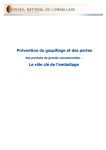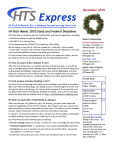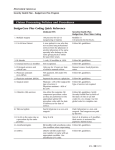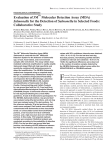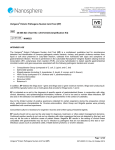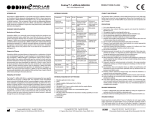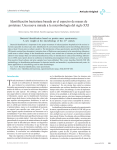Download Principles of Microbiological Troubleshooting in the Industrial Food
Transcript
Principles of Microbiological Troubleshooting in the Industrial Food Processing Environment Food Microbiology and Food Safety Series Food Microbiology and Food Safety publishes valuable, practical, and timely resources for professionals and researchers working on microbiological topics associated with foods, as well as food safety issues and problems. Series Editor Michael P. Doyle, Regents Professor and Director of the Center for Food Safety, University of Georgia, Griffith, GA, USA Editorial Board Francis F. Busta, Director, National Center for Food Protection and Defense, University of Minnesota, Minneapolis, MN, USA Bruce R. Cords, Vice President, Environment, Food Safety & Public Health, Ecolab Inc., St. Paul, MN, USA Catherine W. Donnelly, Professor of Nutrition and Food Science, University of Vermont, Burlington, VT, USA Paul A. Hall, President, AIV Microbiology and Food Safety Consultants, LLC, Hawthorn Woods, IL, USA Ailsa D. Hocking, Chief Research Scientist, CSIRO—Food Science Australia, North Ryde, Australia Thomas J. Montville, Professor of Food Microbiology, Rutgers University, New Brunswick, NJ, USA R. Bruce Tompkin, Formerly Vice President-Product Safety, ConAgra Refrigerated Prepared Foods, Downers Grove, IL, USA For other titles published in this series, go to www.springer.com/series/7131 Principles of Microbiological Troubleshooting in the Industrial Food Processing Environment Jeffrey L. Kornacki Editor Kornacki Microbiology Solutions, Inc., P. O. Box 163, McFarland, WI 53558, USA 123 Editor Jeffrey L. Kornacki Kornacki Microbiology Solutions, Inc. P. O. Box 163 McFarland, WI 53558 USA [email protected] ISBN 978-1-4419-5517-3 e-ISBN 978-1-4419-5518-0 DOI 10.1007/978-1-4419-5518-0 Springer New York Dordrecht Heidelberg London Library of Congress Control Number: 2010921492 © Springer Science+Business Media, LLC 2010 All rights reserved. This work may not be translated or copied in whole or in part without the written permission of the publisher (Springer Science+Business Media, LLC, 233 Spring Street, New York, NY 10013, USA), except for brief excerpts in connection with reviews or scholarly analysis. Use in connection with any form of information storage and retrieval, electronic adaptation, computer software, or by similar or dissimilar methodology now known or hereafter developed is forbidden. The use in this publication of trade names, trademarks, service marks, and similar terms, even if they are not identified as such, is not to be taken as an expression of opinion as to whether or not they are subject to proprietary rights. Printed on acid-free paper Springer is part of Springer Science+Business Media (www.springer.com) Preface This book is borne out of many experiences with many people in hundreds of food processing facilities mainly in North America. The principles of food safety and food quality microbiology range from simple to complex, as does the experience of those in charge of maintaining food safety and quality. Many in our culture assume that the principles are simple, like, “Wash your hands after using the rest room.” However, in my experience, the vast majority of companies that produce foods contaminated with pathogenic bacteria or spoilage organisms are not willfully negligent as some may think. Rather companies often fail for other reasons which could include equipment inadequately designed for appropriate sanitation, poorly constructed facilities, and paradigms that prevent them from recognizing true microbiological risk. Quality assurance/food safety managers become the point persons to deal with food contamination situations. It is a heavy burden that you bear and this book, while useful to anyone wishing to investigate sources of contamination in food processing facilities, is really written with you in mind. This book is written in hopes that it makes your load lighter, your confidence greater, and the food your company produces safer. McFarland, WI Jeffrey L. Kornacki v Acknowledgments The technical editor of this book, Dr. Kornacki, wishes to express his heartfelt thanks to a number of individuals who were instrumental in forming his perspectives on in-plant microbiological investigations. First I want to thank my father, Thomas Kornacki, a retired criminal investigator of 35 years, whose investigations were quite a bit more dangerous but no less complex in their own way. Thanks for your amazing example of observation, logic, and persistence; you are one of a kind. I hope some of your rigorous approach to problems has been passed down to me. I also want to thank Emeritus Professor Wayne Becker, who awakened me to a fascination with living cells and then Emeritus Professor Robert Deibel, both of whom taught inspired courses that I attended in cell biology and Food Bacteriology, respectively, in the 1970s. These courses created in me a passion to one day become a microbiological investigator and troubleshooter in the food industry. Heartfelt thanks are due my graduate Major Professor, the late Elmer Marth, who very graciously allowed me to pursue graduate degrees under his guidance and leadership. How little I knew then the practical value of his insights, vast contribution to the field of food microbiology, and incredible example of diligence, thoroughness, and analysis. I also owe a great debt of gratitude to Dr. Damien Gabis and Dr. Russell Flowers of Silliker Laboratories whose philosophy, example, and approaches matured me immensely as a microbiological troubleshooter through our many food processing plant visits together in the late 1980s and early 1990s. Thanks are also due to Dave Evanson, Dr. Richard Smittle, and Steve Decker also of Silliker for the same reason. Apart from these individuals, their insights and guidance, the excellent contributions of the authors of this book, and the fine example and encouragement of many other professional colleagues through the years, this book would not have been possible. I would be remiss to omit the fine contribution of the authors that contributed to Chapter 2, many of whom are of national and international reputations. I wish to recognize the fine contributions of Robert Behling (Bacillus cereus), Joseph Eifert (Arcobacter), Marilyn Erickson (Clostridium botulinum), Joshua Gurtler (Cronobacter sakazakii), Erick Line and Bradley Stawick (Campylobacter), Roy Radcliff (Mycobacterium paratuberculosis), Elliot Ryser (Listeria monocytogenes), vii viii Acknowledgments and Drs. Ryser and Yan (Staphylococcus aureus and Clostridium perfringens). I am also very grateful for the fine work of Drs. Moorman, Pruett and Weidman with Chapter 10. May you all be kings! (Proverbs 25:2) Thanks also to Mr. Dwight Clough for his considerable assistance with many of the nuts and bolts of putting this book together. McFarland, WI September 9, 2009 Jeffrey L. Kornacki Contents 1 Troubleshooting Costs . . . . . . . . . . . . . . . . . . . . . . . . Jeffrey L. Kornacki 2 Selected Pathogens of Concern to Industrial Food Processors: Infectious, Toxigenic, Toxico-Infectious, Selected Emerging Pathogenic Bacteria . . . . . . . . . . . . . . . Robert G. Behling, Joseph Eifert, Marilyn C. Erickson, Joshua B. Gurtler, Jeffrey L. Kornacki, Erick Line, Roy Radcliff, Elliot T. Ryser, Bradley Stawick, and Zhinong Yan 1 5 3 Solving Microbial Spoilage Problems in Processed Foods . . . . . Rocelle Clavero 63 4 Where These Contaminants Are Found . . . . . . . . . . . . . . . Jeffrey L. Kornacki 79 5 What Factors Are Required for Microbes to Grow, Survive, and Die? . . . . . . . . . . . . . . . . . . . . . . . . . . . Jeffrey L. Kornacki 103 6 Where Do I Start (Beginning the Investigation)? . . . . . . . . . . Jeffrey L. Kornacki 117 7 How Do I Sample the Environment and Equipment? . . . . . . . Jeffrey L. Kornacki 125 8 How Many Samples Do I Take? . . . . . . . . . . . . . . . . . . . Jeffrey L. Kornacki 137 9 When Can I Start Up My Factory or Processing Line Again? . . . Jeffrey L. Kornacki 147 10 Value and Methods for Molecular Subtyping of Bacteria . . . . . Mark Moorman, Payton Pruett, and Martin Weidman 157 Index . . . . . . . . . . . . . . . . . . . . . . . . . . . . . . . . . . . . . 175 ix Contributors Robert G. Behling, B.S. Behling Food Safety Associates, Madison, WI, USA, [email protected] Rocelle Clavero, Ph.D. Sara Lee Corporation, Downers Grove, IL, USA, [email protected] Joseph Eifert, Ph.D. Department of Food Science and Technology, Virginia Tech, Blacksburg, VA, USA, [email protected] Marilyn C. Erickson, Ph.D. University of Georgia, Griffin, GA, USA, [email protected] Joshua B. Gurtler, Ph.D. USDA ARS, Wyndmoor, PA, USA, [email protected] Jeffrey L. Kornacki, Ph.D. Kornacki Microbiology Solutions, Inc., McFarland, WI, USA, [email protected] Erick Line, Ph.D. USDA-ARS, Athens, GA, USA, [email protected] Mark Moorman, Ph.D. The Kellogg Company, Battle Creek, MI, USA, [email protected] Payton Pruett, Ph.D. The Kroger Company, Cincinnati, OH, USA, [email protected] Roy Radcliff, Ph.D. Department of Applied Sciences, Marshfield Clinic, Marshfield, WI, USA, [email protected] Elliot T. Ryser, Ph.D. Michigan State University, East Lansing, MI, USA, [email protected] Bradley Stawick, M.S. Stawick Laboratory Management, Memphis, TN, USA, [email protected] Martin Weidman, Ph.D. Department of Food Science, Cornell University, Ithaca, NY, USA, [email protected] Zhinong Yan, Ph.D. Mol Industries, Grand Rapids, MI, USA, [email protected] xi Chapter 1 Troubleshooting Costs Jeffrey L. Kornacki Abstract Seventy-six million cases of foodborne disease occur each year in the United States alone. Medical and lost productivity costs of the most common pathogens are estimated to be $5.6–9.4 billion. Product recalls, whether from foodborne illness or spoilage, result in added costs to manufacturers in a variety of ways. These may include expenses associated with lawsuits from real or allegedly stricken individuals and lawsuits from shorted customers. Other costs include those associated with efforts involved in finding the source of the contamination and eliminating it and include time when lines are shut down and therefore non-productive, additional non-routine testing, consultant fees, time and personnel required to overhaul the entire food safety system, lost market share to competitors, and the cost associated with redesign of the factory and redesign or acquisition of more hygienic equipment. The cost associated with an effective quality assurance plan is well worth the effort to prevent the situations described. 1.1 The Cost of Food Contamination 1.1.1 The Extent of Microbial Foodborne Illness in America Many have argued that the US food supply is the safest in the world. Nevertheless, the Centers for Disease Control and Prevention (CDC) have estimated that approximately 5,200 deaths, 325,000 hospitalizations, and 76 million cases of foodborne disease occur each year in the United States (Mead et al., 1999). Known pathogens account for an estimated 14 million illnesses, 60,000 hospitalizations, and 1,800 deaths annually (MMWR, 2003). The Foodborne Disease Outbreak Surveillance System of the CDC indicates that over 1,000 outbreaks occur each year. No one can J.L. Kornacki (B) Kornacki Microbiology Solutions, Inc., McFarland, WI, USA e-mail: [email protected] J.L. Kornacki (ed.), Principles of Microbiological Troubleshooting in the Industrial Food Processing Environment, Food Microbiology and Food Safety, C Springer Science+Business Media, LLC 2010 DOI 10.1007/978-1-4419-5518-0_1, 1 2 J.L. Kornacki estimate the human cost in terms of suffering resulting from illness and death of loved ones. Other more quantifiable costs have been estimated (Buzby and Roberts, 1996). 1.1.2 Overview of Costs Associated with Selected Foodborne Pathogens It is difficult to assess the costs associated with foodborne illness. Buzby and Roberts (1996) estimated the costs of seven of these pathogens (Campylobacter jejuni, Clostridium perfringens, Escherichia coli O157:H7, Listeria monocytogenes, Salmonella, Staphylococcus aureus, and Toxoplasma gondii) to be $5.6–9.4 billion (in 1993 dollars) in medical charges and lost productivity alone. Selected foodborne pathogenic bacteria are discussed individually in Chapter 2. Product recalls, whether from foodborne illness or spoilage, result in added costs to manufacturers in a variety of ways. These may include expenses associated with lawsuits from real or allegedly stricken individuals and lawsuits from shorted customers. Other costs include those associated with efforts involved in finding the source of the contamination and eliminating it and include time when lines are shut down and therefore non-productive, additional non-routine testing, consultant fees, time and personnel required to overhaul the entire food safety system, lost market share to competitors, and the cost associated with redesign of the factory and redesign or acquisition of more hygienic equipment. This author is aware of one situation in the United States where a manufacturer in the late 1990s spent $11 million to remodel a portion of their food manufacturing factory and redesign and install some of the processing equipment in the aftermath of a national food infection and recall. Settlements outside of the court room can also be in millions of dollars. Serious damage to a company’s brand name can and has occurred even in instances when the company issuing the recall is not at fault (e.g., in cases where a product has been contaminated by a supplier’s ingredient). Some companies have resorted to changing their name as a result. Damage to a company’s reputation and profit margin can also result in loss of jobs and salary reductions. In some instances, a recall from a competitor has even resulted in market losses due to brand confusion. Food safety is in everyone’s best interest. 1.1.3 Costs Associated with Spoilage and Foods with Microbial Indicators of “Unacceptable Quality” Many of the same costs listed above apply to spoiled food products. Spoiled foods are not necessarily hazardous but are organoleptically unacceptable. Consequently, these foods may be perceived as dangerous resulting in expenses associated with product recalls, lawsuits from allegedly stricken individuals and shorted customers, 1 Troubleshooting Costs 3 efforts to find and eliminate the source(s) of the contamination, non-productive lines, additional testing, consultant fees, lost market share to competitors, and the costs associated with redesign of the facility and/or equipment. Food spoilage is discussed in Chapter 3. There are even economic consequences to otherwise acceptable foods, wherein levels of selected quality indicators (e.g., coliforms) have been exceeded. These situations may result in rejection of product by suppliers. There are frequent disputes between companies over what is the correct number of non-pathogenic contaminants in a sample. Effective sampling is not as straightforward as taking a sample and testing it due to the potential for non-homogeneous microbial populations in the product and there are added expenses to taking and testing the proper number of samples. Sampling plans are addressed in Chapter 8. The cost associated with an effective quality assurance plan is well worth the effort to prevent the situations just described. The savings in terms of maintenance and repair and increased revenues resulting from higher quality foods due to effective microbiological control efforts in processing facilities are often overlooked. Consequently, there is great need to understand how to locate and control microbial contaminants in processed foods and in the environments in which they are produced. That is what the main thrust of this book is about. References Buzby JC, Roberts T (1996) ERS updates US foodborne disease costs for seven pathogens. ABI/INFORM Global. 3:20–25. http://www.ers.usda.gov/publications/foodreview/sep1996/ sept96e.pdf. Accessed 17 July 2008 Mead PS, Slutsker L, Dietz V, McCaig LF, Bresee JS, Shapiro C, Griffin PM, Tauxe RV (1999) Food-related illness and death in the United States. Emerg Infect Dis (Online) 5(5):607–625 http://www.cdc.gov/ncidod/eid/vol5no5/mead.htm. Accessed 17 July 2008 MMWR (2003) Preliminary FoodNet data on the incidence of foodborne illnesses–selected sites, United States, 2002. 52(15):340–343. http://www.cdc.gov/mmwr/preview/mmwrhtml/ mm5215a4.htm. Accessed 17 July 2008 Chapter 2 Selected Pathogens of Concern to Industrial Food Processors: Infectious, Toxigenic, Toxico-Infectious, Selected Emerging Pathogenic Bacteria Robert G. Behling, Joseph Eifert, Marilyn C. Erickson, Joshua B. Gurtler, Jeffrey L. Kornacki, Erick Line, Roy Radcliff, Elliot T. Ryser, Bradley Stawick, and Zhinong Yan Abstract This chapter, written by several contributing authors, is devoted to discussing selected microbes of contemporary importance. Microbes from three categories are described by the following: (1) infectious invasive agents like Salmonella, Listeria monocytogenes, and Campylobacter; (2) toxigenic pathogens such as Staphylococcus aureus, Bacillus cereus, and Clostridium botulinum; and (3) toxico-infectious agents like enterohemorrhagic Escherichia coli and Clostridium perfringens. In addition, emerging pathogens, like Cronobacter (Enterobacter) sakazakii, Arcobacter spp., and Mycobacterium avium subspecies paratuberculosis are also described. In most cases, the discussion includes a description of the organism itself, economic impact of the organism (due to disease, loss of market share, etc.), disease syndromes/infectious process, infectious dose, reservoirs (where the organism originates in the food processing chain), foods associated with the organism, and the occurrence of the organism in food processing environments. 2.1 Introduction This chapter will not address all the pathogenic microbes that are of concern in all foods or all food processing environments. However, selected pathogens will be described which illustrate typical organism types (i.e., infectious, toxigenic, toxicoinfectious) of common concern in food manufacturing environments. A few selected emerging foodborne pathogens will also be discussed. Detailed reviews and descriptions of foodborne pathogens can be found in a number of references (Doyle, 1989; Jay et al., 2005; Doyle et al., 1997). The later part of this chapter will address selected emerging microbial pathogens of concern. R.G. Behling (B) Behling Food Safety Associates, Madison, WI, USA e-mail: [email protected] J.L. Kornacki (ed.), Principles of Microbiological Troubleshooting in the Industrial Food Processing Environment, Food Microbiology and Food Safety, C Springer Science+Business Media, LLC 2010 DOI 10.1007/978-1-4419-5518-0_2, 5 6 R.G. Behling et al. Post-process contamination from the factory environment is a very common (and in this authors opinion – the most common) means by which commercially processed foods are contaminated (Kornacki, 2000; Allan et al., 2004; Reij and Den Aantrekker, 2004). Examples of post process contamination from the food processing environment are illustrated in Table 2.1. In this book we refer to “commercially processed” foods as those which have been modified from the raw state into a ready-to-eat format in an industrial manufacturing environment. Environmental contamination can come from ingredients used in processing, whether directly or indirectly, worker’s hands, shoes, walls, floors, and a myriad of other sources. This chapter is devoted to discussing selected microbes of contemporary importance. These microbes fit into three categories which include (1) infectious invasive agents like Salmonella (Section 2.2), Listeria monocytogenes (Section 2.3), Campylobacter (Section 2.4), and enteroinvasive Escherichia coli, (2) toxigenic pathogens like Staphylococcus aureus (Section 2.5), Bacillus cereus (Section 2.6), and Clostridium botulinum (Section 2.7). (The growth and production of pre-formed toxin in foods is a particular concern with enterotoxin producing strains of Staphylococcus, B. cereus, and C. botulinum.) (3) toxico-infectious agents like enterotoxigenic and enterohemorrhagic E. coli (Section 2.8) and Clostridium perfringens (Section 2.9) are described. In addition emerging pathogens, like Cronobacter (Enterobacter) sakazakii (Section 2.11), Arcobacter spp. (Section 2.10), and Mycobacterium avium subspecies paratuberculosis (Section 2.12), are also described. Infectious vs. toxigenic bacterial pathogens In general, infectious pathogens may enter the body and invade or colonize host tissues. This requires some time (e.g., usually greater than 8 h for onset of illness). Toxigenic pathogens create food “poisoning” situations by producing an enterotoxin in the food. Incubation times for onset of disease from toxigenic microbes are often shorter than for invasive pathogens and can be as little as 1 h, as in the case of staphylococcal enterotoxin-induced illness. The short incubation time in comparison to the infectious pathogens results because the agent of illness, the toxin, is pre-formed in the food and ingested. Illness is not contingent upon the organism migrating to the intestinal tract implanting and growing. Selected examples of invasive and infectious foodborne pathogens and their importance in various foods follow. 2.2 Salmonella, an Infectious Invasive Agent Salmonella spp. are an example of an “invasive” infectious pathogen and are second only to the thermophilic Campylobacter spp. (e.g., jejuni, coli) in the number of foodborne disease cases per year attributed to bacteria (Table 2.2). C. jejuni S. enteritidis S. ealing S. berta S. typhimurium S. Napoli S. eastbourne L. monocytogenes L. monocytogenes C. botulinum S. aureus E. coli O157:H7 Y. enterocolitica S. typhi S. aureus S. aureus E. coli O157:H7 S. Enteritidis PT4 S. m˝unchen S. typhimurium E. coli O157:H7 B. cereus Y. enterocolitica L. monocytogenes Tuna salad Ice cream Infant formulae Soft cheese Cooked sliced ham Chocolate Chocolate Butter Hot dogs Canned salmon Lasagne Different foods Chocolate milk Canned meat Crabmeat Canned mushrooms Flavored yogurt Pastry Yeasts Pasteurized milk Pasteurized milk Pasteurized milk Pasteurized milk Mexican type cheese Adapted from Reij and Aantrekker (2004); and ICMSF (2002). Pathogen Product Probably chicken handled in same kitchen Pasteurized ice cream mix in tanker truck previously used for transporting raw liquid eggs Contamination from the processing environment, insulation material of the drying tower Cheese ripening in buckets previously used for chicken carcasses Cooked ham placed into containers previously used for curing Possibly contaminated water used in double-walled pipes, tanks Contamination from the processing environment Contamination from the processing environment Contamination from the processing environment Contamination from the processing environment, cooling water Growth of S. aureus in the processing equipment, improper cleaning Contaminated meat grinder and equipment at retail level Probably during manual mixing of pasteurized milk and chocolate Use of non-potable water for can cooling Contamination during manual picking of cooked meat Possible growth of S. aureus in the brine bath before canning Pump previously used for raw milk Equipment previously used for raw eggs or insufficiently cleaned piping and nozzles used for cream Contamination from the processing environment Possibly cross-connection between raw and pasteurized milk Contamination from pipes and rubber seals of the bottling line Filling equipment Post-process contamination Contamination from the processing environment Comment Table 2.1 Examples of outbreaks attributed to environmental contamination 2 Selected Pathogens of Concern to Industrial Food Processors 7 8 R.G. Behling et al. Table 2.2 Estimated annual foodborne disease from selected pathogens Bacterium Number of total illness Total illness (%) Hospitalized (%) Deaths (%) Number of deaths Campylobacter Salmonella (non-typhoidal) Listeria monocytogenes E. coli O157:H7 Clostridium perfringens Staphylococcus Shigella 2M 1.3 M 2,493 62,458 248,520 185,060 89,648 14.2 9.7 0.0 0.5 1.8 1.3 0.6 17.3 25.6 3.8 3.0 0.1 2.9 2.0 5.5 30.6 27.6 2.9 0.4 0.1 0.8 99 553 499 52 7 2 14 Adapted from Mead et al. (1999). M = million. 2.2.1 Salmonella: The Organism Salmonella species are gram-negative, rod-shaped, usually motile, members of the taxonomic family, Enterobacteriaceae. Despite great advances in molecular genetic approaches to identification and characterization these organisms are still serologically defined, i.e., by their somatic (O) and (usually) flagellar (H) and sometimes capsular (Vi) antigens. Over approximately 2,400 different serotypes are known to exist. The nomenclature of this microbe has gone through a number of changes resulting in some confusion. In this author’s opinion it is easiest to refer to the serotype designation (e.g., Salmonella serotype Typhimurium) as opposed to other nomenclatural approaches (e.g., Salmonella enterica serovar Typhimurium). 2.2.2 Cost Costs that are difficult to measure include pain and suffering, death, and loss of a company’s reputation. Other costs may include lost market share, lost jobs or reduced wages, lawsuits from shorted customers, the price to remanufacture products that have been destroyed, the cost to recondition contaminated product (if possible and allowed), and lawsuits from stricken individuals or class actions (see Chapter 1). The United States Department of Agriculture (USDA) estimated that 696,000–3,800,000 cases of non-typhoid, foodborne Salmonellosis occurs annually with an estimated cost of 0.9–12.2 billion dollars (Buzby and Roberts, 1996). 2.2.3 Disease Syndromes Salmonella can cause a number of disease syndromes including typhoid fever from Salmonella typhi (rarely found in foods produced in the United States). However, 2 Selected Pathogens of Concern to Industrial Food Processors 9 other strains of Salmonella cause gastroenteritis, bacteremia, and enteric or paratyphoid fever (Hanes, 2003). Onset times typically range from 18 to 36 h (IAFP, 1999). Symptoms include abdominal pain, diarrhea, occasionally with mucous or blood. Nausea and vomiting often occur but are rarely severe or protracted. A fever of 38–39◦ C is common, often after a chill. In many instances the disease resolves within 48 h. However, it can last with diarrhea and low-grade fever for 10–14 days. In severe cases dehydration may lead to hypotension, cramps, oliguria, and uremia. Symptoms are often more severe in infants and adults over 60 years of age. Fatalities rarely exceed 1% of the affected population and are generally limited to infants, elderly, and debilitated individuals (Hanes, 2003). Nevertheless, Salmonella infection accounts for more foodborne deaths (31%) in the United States than any other foodborne pathogen (Mead et al., 1999). Furthermore, multi-drug-resistant Salmonella DT104 has been associated with double the hospitalization rate and ten times the case fatality rate of other foodborne Salmonella (Hanes, 2003). The presence of viable salmonellae in the gastrointestinal tract indicates that the organism survived a variety of non-specific host defenses including lactoperoxidase in saliva, stomach acidity, mucous secretions from intestinal goblet cells, and sloughing of luminal epithelial cells. In addition, they must survive non-specific phagocytic cells, immune responses associated with specific T and B lymphocytes, Peyer’s patches, and complement inactivation (D’Aoust, 1991). Once they have survived these conditions, they attach to intestinal tissues and mesenteric lymph follicles resulting in enterocolitis. Endotoxin is produced, leukocytes move into the infected tissues, and increased mucous secretion occurs. Mucosal inflammation results from the release of prostaglandins by leukocytes which also activates adenyl cyclase in intestinal epithelial cells causing increased fluid secretion into the intestinal lumen and resulting in diarrhea. Septicemia and other chronic conditions result when host defenses fail to keep these invasive Salmonella in check (D’Aoust, 1991). 2.2.4 Infectious Dose The infectious dose appears to be very low as evidenced by some foods implicated in foodborne disease with only a few cells recovered. An example of this occurred in a 1994 frozen dessert-associated outbreak wherein the level of Salmonella serotype Enteritidis was reported to have a most probable number (MPN) range of 4 cells per 1,000 g to 46 cells per 100 g with a median of 93 cells in 1,000 g (Vought and Tatini, 1998). The 95% confidence interval for these MPN values was from < 1 cell per 1,000 g to 2.4 cells/g. The number of Salmonella serotype Enteritidis cells per serving was estimated at 25 cells. In this study, the infective dose appeared to be less than 28 cells. Evidence from other studies indicates that from 1 to 10 cells may constitute an infectious dose in some circumstances (D’Aoust et al., 1985 and Kapperud et al., 1990). 10 R.G. Behling et al. 2.2.5 Reservoirs Salmonellae are widespread in the natural environment and a number of these are host specific (e.g., Salmonella serotype Pullorum in chickens, Salmonella serotype Cholera-Suis in pigs). In many countries poultry remain the dominant reservoir, although pork, beef, and mutton have served as vehicles of infection. The eggborne pandemic of Salmonella serotype Enteritidis phage type 4 in Europe and phage type 8 in North America illustrates the importance of poultry products as vehicles of human salmonellosis. 2.2.6 Foods Associated with Human Salmonella spp. Infection Salmonella spp. have a long history of food contamination and have caused illness from ingestion of a wide variety of foods. These organisms have been a particular concern with foods of animal origin (e.g., meat, poultry, eggs, and dairy products). Dry foods and fruit and vegetableborne outbreaks have also occurred. One multistate cantaloupeborne outbreak affected more than 25,000 across 30 states (Ries et al., 1990). Major outbreaks have occurred with chocolate, milk powder, potato salad, egg salad, raw milk, mustard dressing, salad base, cheddar cheese, liver pate, aspic glaze, pasteurized milk, egg drink, cuttlefish, cooked eggs, cantaloupes, fruit soup, mayonnaise, paprika chips, ice cream, and alfalfa sprouts (D’Aoust, 1997). In the 1994 frozen dessert-associated outbreak mentioned above, an estimated 224,000 people were infected with Salmonella serotype Enteritidis. The source of the organism was traced to contaminated post-pasteurized ice cream mix which had been shipped in tank trucks previously used to transport raw eggs (Hennessy et al., 1996). 2.2.7 Dry Foods Dry products are not often associated with microbial contamination problems. However, salmonellae have been a particular concern with some dry foods and dry food production environments. Control of these organisms is a priority among industries that produce dried foods such as dry milk, infant formula, chocolate, dry soup mixes, and rendered animal proteins (an ingredient in animal feed and pet food). Human outbreaks of disease have been reported with dry milk, chocolate, and even paprika potato chips, dry cereal, and peanut butter (D’Aoust et al., 1975; Greenwood and Hopper, 1983; Kapperud et al., 1990; Lehmacher et al., 1995; Weissman et al., 1977; CDC, 2007, 2009). It is important to note that simply because a microbe cannot grow in a low water activity food, it may still survive for some time. Factors that influence microbial growth survival and death are discussed in Chapter 5. 2 Selected Pathogens of Concern to Industrial Food Processors 11 2.2.8 Food Processing Environments A wide variety of food factory environments may be contaminated with this microbe due to their widespread occurrence in the natural environment and likely presence in some raw ingredients which may enter factory environments. In the author’s experience, birds, which are frequent carriers of this organism, may find roosts on factory roofs or roof-associated structures (e.g., air intakes for air handling units). Most food processing facilities have flat roofs and many are not adequately sloped to drains resulting in collection of standing water. Standing water on roof tops will permit the growth of salmonellae to high numbers. Entry of salmonellae in the factory environment may occur through inappropriately sealed roof top-associated penetrations. Other routes of entry are described in Chapter 4. In the author’s experience, it is rare that the post-cook side of a factory is contaminated with more than one serotype of Salmonella. Most often the Salmonella serotype found on the finished side of the facility is its “signature” organism or “house-bug.” It appears that each environment selects for the strain which has likely adapted to its environment. However, exceptions to this observation have been noted and the presence of multiple serotypes suggests multiple sources for the microbe. The author has observed sporadic detection of a specific serotype of Salmonella in some dry product processing environments for 10 or more years. 2.3 L. monocytogenes, an Infectious Invasive Agent The very widespread (some say ubiquitous) distribution of this organism in the natural environment coupled with its resistance to freezing, growth in the presence of 10% salt, survival in concentrated brine solutions, and its ability to grow at 1–45◦ C (optimum at 35–37◦ C) makes control of this organism in the processing environment challenging. Eradication of this organism from ready-to-eat meat and poultry processing environments is unlikely given current technology (Tompkin et al., 1999). Hence, implementation of rigorous controls is essential to prevent processed food contamination. 2.3.1 The Organism L. monocytogenes is a gram-positive, short (0.4–0.5×0.5–2 μm) non-sporeforming, rod-shaped, microaerobic bacterium that exhibits tumbling motility. The organism appears translucent with a “characteristic” blue-green sheen when observed under oblique lighting. However, some technicians are better than others at visualizing this phenomenon. It is typically weakly β-hemolytic on horse blood agar and exhibits a characteristic CAMP reaction on sheep blood agar when streaked perpendicularly to S. aureus (enhanced hemolysis) and Rhodococcus equi (hemolysis not enhanced). Other than Listeria seeligeri, the remaining Listeria spp. 12 R.G. Behling et al. Table 2.3 Key reactions of Listeria Camp reaction (enhanced hemolysis) Species Staphylococcus streak Rhodococcus equi streak Rhamnose Xylose monocytogenes ivanovii innocua welshimeri seeligeri grayi b + – – – + – –a + – – – – + – Variable Variable – Variable – + – + + – a Rare strains may show a region of enhanced hemolysis near both the Staphylococcus and the Rhodococcus streaks b This species is mannitol positive yield different CAMP reactions (Table 2.3). Typical L. monocytogenes isolates ferment rhamnose, dextrose, esculin, and maltose but not xylose and mannitol (Datta, 2003). The CAMP reaction and key biochemical reactions have been traditionally used to confirm cultures. However, numerous Listeria identification test kits are now available that greatly expedite this process without the use of the CAMP reaction. 2.3.2 Cost Approximately 2,518 cases of foodborne listeriosis, including ∼500 fatalities, occur annually in the United States at an estimated cost of $2.3 billion, making listeriosis the second most costly foodborne illness after salmonellosis which some have estimated at 2.33 billion dollars (Mead et al., 1999; Buzby and Roberts, 1996). Consequently, foodborne listeriosis has been targeted by many public heath programs, most notably Healthy People 2010 – a comprehensive nationwide health promotion and disease prevention program developed by the Department of Health and Human Services to reduce bacterial infections and enhance life expectancy/quality. 2.3.3 Disease Syndromes Two types of listeriosis are recognized – (a) an invasive form that can be lifethreatening in newborn infants, the elderly, and immunocompromised adults and (b) a less common self-limiting gastrointestinal illness. In the gastrointestinal form, flu-like symptoms (e.g., diarrhea, vomiting, fever) may occur 18–24 h after ingestion of the contaminated food. In contrast, invasive listeriosis has an onset time of 3 to as long as 70 days after which adults typically experience septicemia, meningitis, or endocarditis, whereas unborn fetuses develop abscesses in their liver, lungs,




















